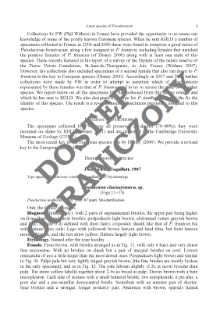- Search in all Repository
- Literature and maps
- Archeology
- Mills database
- Natural sciences
Advanced search
Advanced search
Advanced search
Advanced search
Advanced search

Object
Title: Review of the millipede genus Cylindrodesmus Pocock, 1889 (Diplopoda: Polydesmida: Haplodesmidae)
Creator:
Golovač, Sergej Il'ič (1952– ) ; Hoffmann, R. L. ; Knapinski S. ; Adis, Joachim (1950–2007) ; Polska Akademia Nauk. Muzeum i Instytut Zoologii
Date issued/created:
Resource type:
Subtitle:
Fragmenta Faunistica, vol. 44, no. 2 ; Review of Cylindrodesmus ; Rewizja rodzaju krocionogów Cylindrodesmus Pocock, 1889 (Diplopoda: Polydesmida: Haplodesmidae)
Publisher:
Museum and Institute of Zoology, PAS
Place of publishing:
Description:
Bibliogr. p. 198-200 ; P. 179-201 : ill. ; 25 cm ; Abstarct in Polish. Taxa in Latin.
Type of object:
Abstract:
The genus Cylindrodesmus seems to actually comprise only two unquestioned species, (1) C. hirsutus POCOCK, 1889 (the type species), a pantropical anthropochore with bisexual populations, usually referred to as C. hirsutus, living in various places in the tropics, and parthenogenetic populations, normally referred to as C. laniger SCHUBART, 1944, occurring in numerous places in the tropics as well as in a few European hothouses, and (2) C. villosus POCOCK, 1898, from Rotuma Island, Pacific Ocean. Lectotypes of C. hirsutus, C. villosusas well as of C. palmyrae CHAMBERLIN, 1954, the latter a long-established junior synonym of C. laniger, have been select-ed, illustrated and discussed. As there are obviously no characters that would allow to distinguish C. laniger from C. hirsutus other than those apparently related to parthenogenesis, e.g. generally smaller body size, nor-mally a bit more strongly falcate/sigmoid gonopods in the residual males, and the vulvae devoid of well-developed receptacula seminis, the following new synonym is proposed: C. hirsutus POCOCK, 1889 = C. laniger SCHUBART, 1944, syn.n. Revision of the types of Inodesmus peduncularis LOOMIS, 1934, from Surinam, also results in its formal synonymy under C. hirsutus, syn.n. It is certainly because of the numerous C. hirsutus populations being thelytokous, more or less devoid of males, that this species, and genus, has a pretty long list of synony-mies. In addition, Elatosus CHAMBERLIN, 1945, monobasic, with E. pygmaeus CHAMBERLIN, 1945, from Java, is herewith formally synonymized with Cylindrodesmus, and E. pygmaeus with C. hirsutus, both syn.n.
Relation:
Volume:
Issue:
Start page:
End page:
Detailed Resource Type:
Format:
Resource Identifier:
oai:rcin.org.pl:54255 ; 10.3161/00159301FF2001.44.2.179
Source:
MiIZ PAN, call no. P.256, T. 44 nr 2 ; MiIZ PAN, call no. P.4664, T. 44 nr 2 ; click here to follow the link
Language:
Rights:
Rights Reserved - Restricted Access
Terms of use:
Digitizing institution:
Museum and Institute of Zoology of the Polish Academy of Sciences
Original in:
Library of the Museum and Institute of Zoology of the Polish Academy of Sciences
Projects co-financed by:
Programme Innovative Economy, 2010-2014, Priority Axis 2. R&D infrastructure ; European Union. European Regional Development Fund
Access:
Object collections:
- Digital Repository of Scientific Institutes > Partners' collections > Museum and Institute of Zoology PAS > Scientific Journals
- Digital Repository of Scientific Institutes > Partners' collections > Museum and Institute of Zoology PAS > MIZ PAN Publications > Fragmenta Faunistica
- Digital Repository of Scientific Institutes > Literature > Journals/Articles
Last modified:
Feb 4, 2025
In our library since:
Jun 12, 2015
Number of object content downloads / hits:
138
All available object's versions:
https://rcin.org.pl./publication/61107
Show description in RDF format:
Show description in RDFa format:
Show description in OAI-PMH format:
Objects Similar
Scheller, Ulf Adis, Joachim (1950–2007) Polska Akademia Nauk. Muzeum i Instytut Zoologii International Congress of Myriapodology (11 ; 1999 ; Białowieża)
Golovač, Sergej Il'ič (1952– ) Adis, Joachim (1950–2007) Polska Akademia Nauk. Muzeum i Instytut Zoologii
Golovač, Sergej Il'ič (1952– ) Hoffman, Richard Lawrence (1927–2012) Polska Akademia Nauk. Muzeum i Instytut Zoologii International Congress of Myriapodology (11 ; 1999 ; Białowieża)
Mihalëva, Elena Valentinovna Wytwer, Jolanta (1958– ) Golovač, Sergej Il'ič (1952– ) Polska Akademia Nauk. Muzeum i Instytut Zoologii
Adis, Joachim (1950–2007) Golovač, Sergej Il'ič (1952– ) Polska Akademia Nauk. Muzeum i Instytut Zoologii
Adis, Joachim (1950–2007) Golovač, Sergej Il'ič (1952– ) Wilck, Lars Hansen, Berit Polska Akademia Nauk. Muzeum i Instytut Zoologii International Congress of Myriapodology (11 ; 1999 ; Białowieża)
International Congress of Myriapodology (11 ; 1999 ; Białowieża) Golovač, Sergej Il'ič (1952– ) Wytwer, Jolanta (1958– )
Disney, R. H. L. Mihajlovskaâ, Marina Vladimirovna Polska Akademia Nauk. Muzeum i Instytut Zoologii

 INSTYTUT ARCHEOLOGII I ETNOLOGII POLSKIEJ AKADEMII NAUK
INSTYTUT ARCHEOLOGII I ETNOLOGII POLSKIEJ AKADEMII NAUK
 INSTYTUT BADAŃ LITERACKICH POLSKIEJ AKADEMII NAUK
INSTYTUT BADAŃ LITERACKICH POLSKIEJ AKADEMII NAUK
 INSTYTUT BADAWCZY LEŚNICTWA
INSTYTUT BADAWCZY LEŚNICTWA
 INSTYTUT BIOLOGII DOŚWIADCZALNEJ IM. MARCELEGO NENCKIEGO POLSKIEJ AKADEMII NAUK
INSTYTUT BIOLOGII DOŚWIADCZALNEJ IM. MARCELEGO NENCKIEGO POLSKIEJ AKADEMII NAUK
 INSTYTUT BIOLOGII SSAKÓW POLSKIEJ AKADEMII NAUK
INSTYTUT BIOLOGII SSAKÓW POLSKIEJ AKADEMII NAUK
 INSTYTUT CHEMII FIZYCZNEJ PAN
INSTYTUT CHEMII FIZYCZNEJ PAN
 INSTYTUT CHEMII ORGANICZNEJ PAN
INSTYTUT CHEMII ORGANICZNEJ PAN
 INSTYTUT FILOZOFII I SOCJOLOGII PAN
INSTYTUT FILOZOFII I SOCJOLOGII PAN
 INSTYTUT GEOGRAFII I PRZESTRZENNEGO ZAGOSPODAROWANIA PAN
INSTYTUT GEOGRAFII I PRZESTRZENNEGO ZAGOSPODAROWANIA PAN
 INSTYTUT HISTORII im. TADEUSZA MANTEUFFLA POLSKIEJ AKADEMII NAUK
INSTYTUT HISTORII im. TADEUSZA MANTEUFFLA POLSKIEJ AKADEMII NAUK
 INSTYTUT JĘZYKA POLSKIEGO POLSKIEJ AKADEMII NAUK
INSTYTUT JĘZYKA POLSKIEGO POLSKIEJ AKADEMII NAUK
 INSTYTUT MATEMATYCZNY PAN
INSTYTUT MATEMATYCZNY PAN
 INSTYTUT MEDYCYNY DOŚWIADCZALNEJ I KLINICZNEJ IM.MIROSŁAWA MOSSAKOWSKIEGO POLSKIEJ AKADEMII NAUK
INSTYTUT MEDYCYNY DOŚWIADCZALNEJ I KLINICZNEJ IM.MIROSŁAWA MOSSAKOWSKIEGO POLSKIEJ AKADEMII NAUK
 INSTYTUT PODSTAWOWYCH PROBLEMÓW TECHNIKI PAN
INSTYTUT PODSTAWOWYCH PROBLEMÓW TECHNIKI PAN
 INSTYTUT SLAWISTYKI PAN
INSTYTUT SLAWISTYKI PAN
 SIEĆ BADAWCZA ŁUKASIEWICZ - INSTYTUT TECHNOLOGII MATERIAŁÓW ELEKTRONICZNYCH
SIEĆ BADAWCZA ŁUKASIEWICZ - INSTYTUT TECHNOLOGII MATERIAŁÓW ELEKTRONICZNYCH
 MUZEUM I INSTYTUT ZOOLOGII POLSKIEJ AKADEMII NAUK
MUZEUM I INSTYTUT ZOOLOGII POLSKIEJ AKADEMII NAUK
 INSTYTUT BADAŃ SYSTEMOWYCH PAN
INSTYTUT BADAŃ SYSTEMOWYCH PAN
 INSTYTUT BOTANIKI IM. WŁADYSŁAWA SZAFERA POLSKIEJ AKADEMII NAUK
INSTYTUT BOTANIKI IM. WŁADYSŁAWA SZAFERA POLSKIEJ AKADEMII NAUK




































